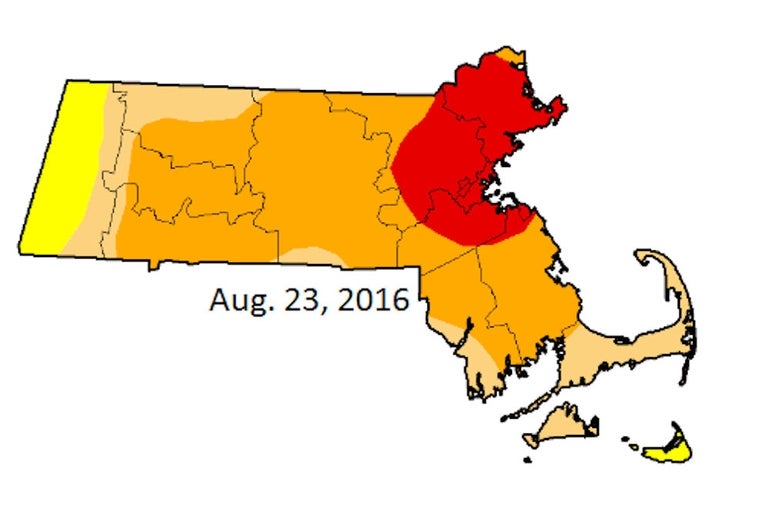Drought severity expands
 U.S. Drought Monitor
Severe drought has expanded to much of the state.
U.S. Drought Monitor
Severe drought has expanded to much of the state.
In the midst of a summer devoid of significant rainfall, all of Massachusetts is now at least "abnormally dry" and the portion feeling the effects of a "severe drought" or worse has expanded to cover almost 75 percent of the state, according to the U.S. Drought Monitor.
The Drought Monitor, a collaboration between federal government agencies and educational institutions, on Thursday morning added large swaths of Plymouth and Bristol counties to its "severe drought" category, bringing the total area of the state under that classification to 55.36 percent.
The Monitor also declared Nantucket -- which had been the one part of the state yet to be classified at all -- "abnormally dry," one step short of a drought. Nantucket and a sliver of western Berkshire County are the only areas of the state not considered to be in a drought, the Monitor said.
There was no change to the area classified as dealing with an "extreme drought" Thursday. All of Suffolk County, almost all of Essex County, most of Middlesex and Norfolk counties, and a slice of Plymouth County -- a total of 16.86 percent of the state's landmass and a sizable chunk of its population -- remain in an "extreme drought," the second highest category the Drought Monitor uses.
Boston has measured just 1.72 inches of rain so far in August, almost an inch short of average, according to the National Weather Service. The city got just 0.87 inches of rainfall in July, more than 2.5 inches below average. Worcester has seen 3.96 inches this month, but is also an inch below average, the NWS said.
Massachusetts has been under its own official drought declaration since July 1 and the arid conditions have been blamed for contributing to wild fires, an outbreak of gypsy moths, higher rates of ant infestation, smaller than usual apples, loss of crops, and an elevated population of mosquitoes carrying West Nile virus.
"Rainfall during the monitoring period was heaviest in northern New England, although beneficial showers occurred in some of the hardest-hit drought areas. However, rain was neither heavy nor sustained enough to dent the region's two core areas of severe to extreme drought," the Drought Monitor wrote. "Through August 23, Northeastern communities with year-to-date precipitation deficits of 7 to 8 inches included Concord, New Hampshire; Boston, Massachusetts; Hartford, Connecticut; and Islip, New York."
On Sunday, the U.S. Department of Agriculture rated 72 percent of pastures in Massachusetts to be in "poor to very poor" condition and rated topsoil moisture "short to very short" across 90 percent of the state.
Based on the Palmer Drought Severity Index, a National Oceanic and Atmospheric Administration indicator that uses temperature and precipitation data to determine relative dryness, the three month period between May 1 and July 31 was the driest for those three months in Massachusetts since 1966 and the ninth driest on record.
The Baker administration has encouraged the public to use water-saving techniques -- including shortening shower times, sweeping outdoor spaces instead of cleaning them with hoses and limiting watering of lawns -- and to be mindful of the dry conditions when using grills or fires outdoors.









0 Comments